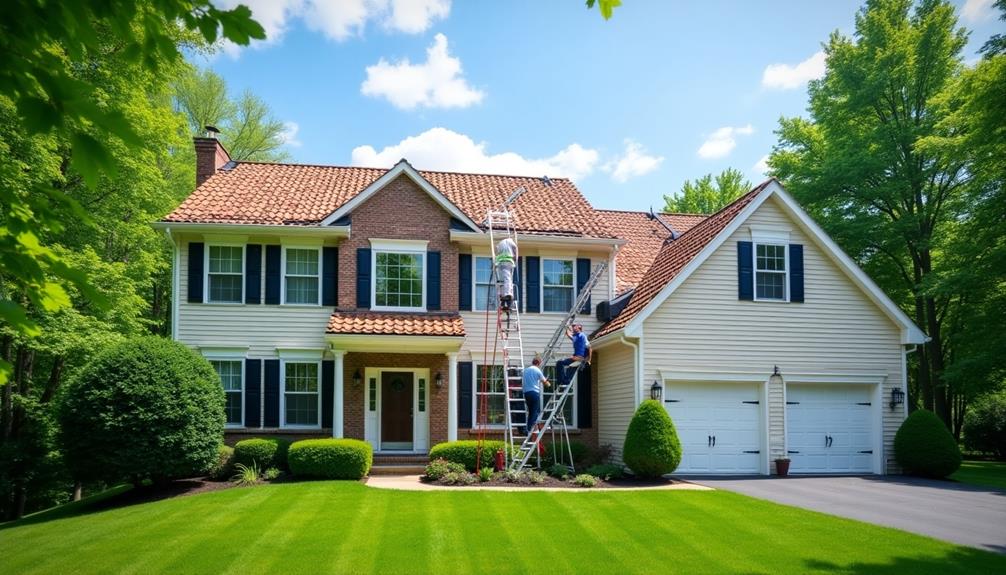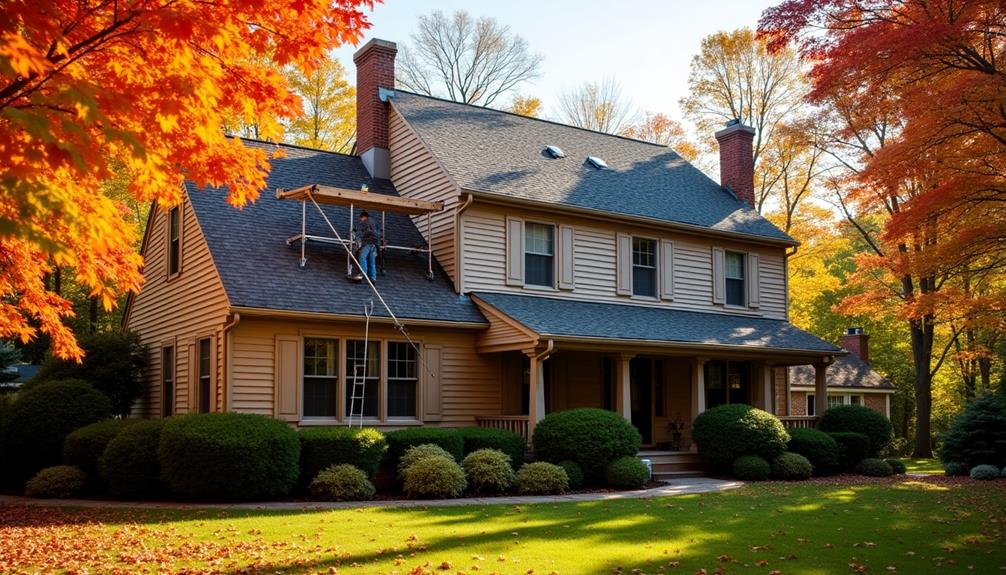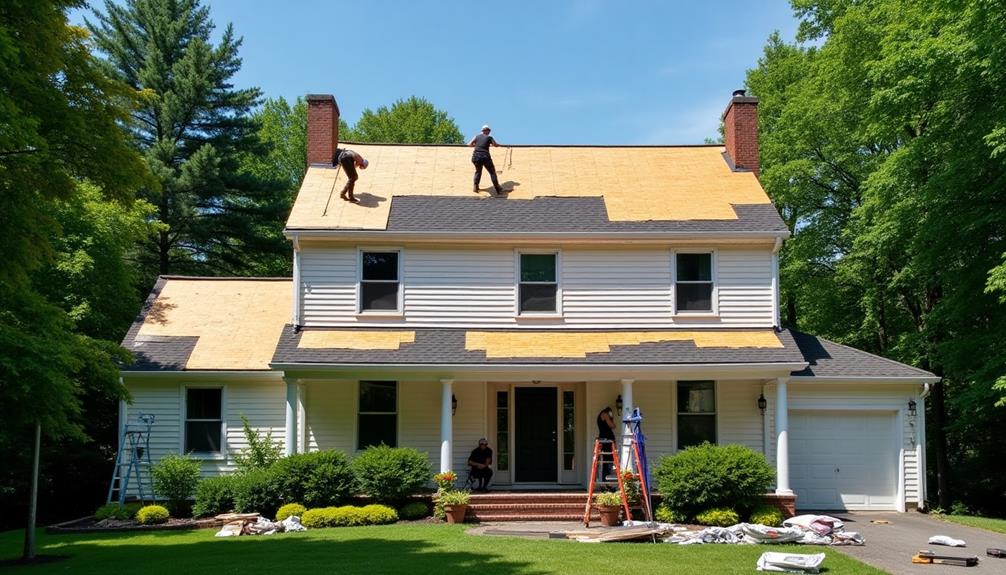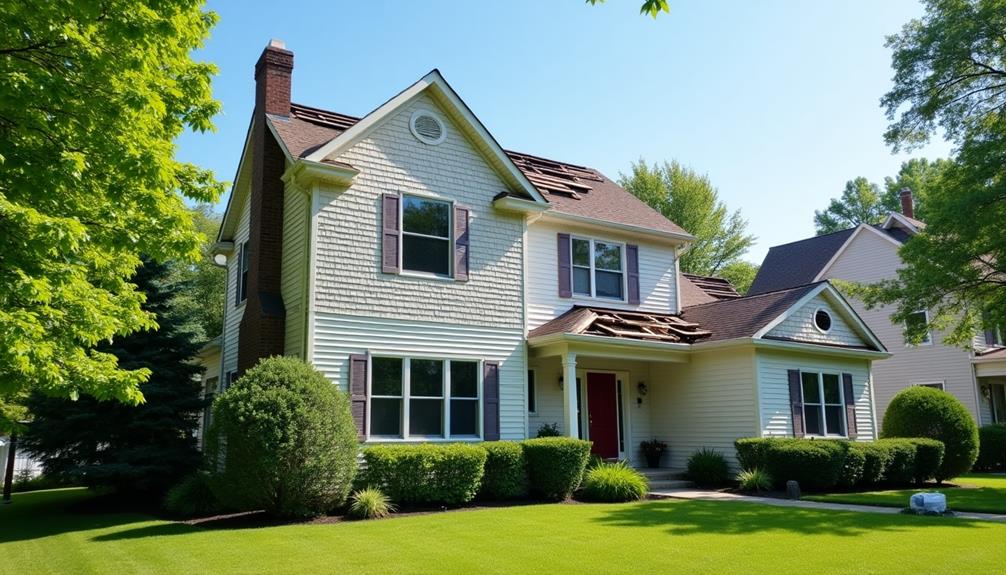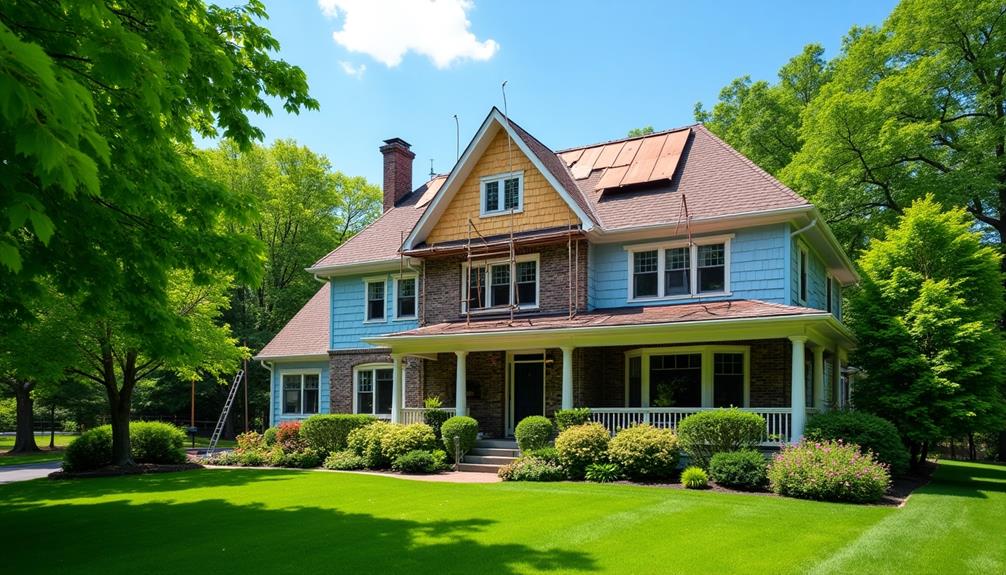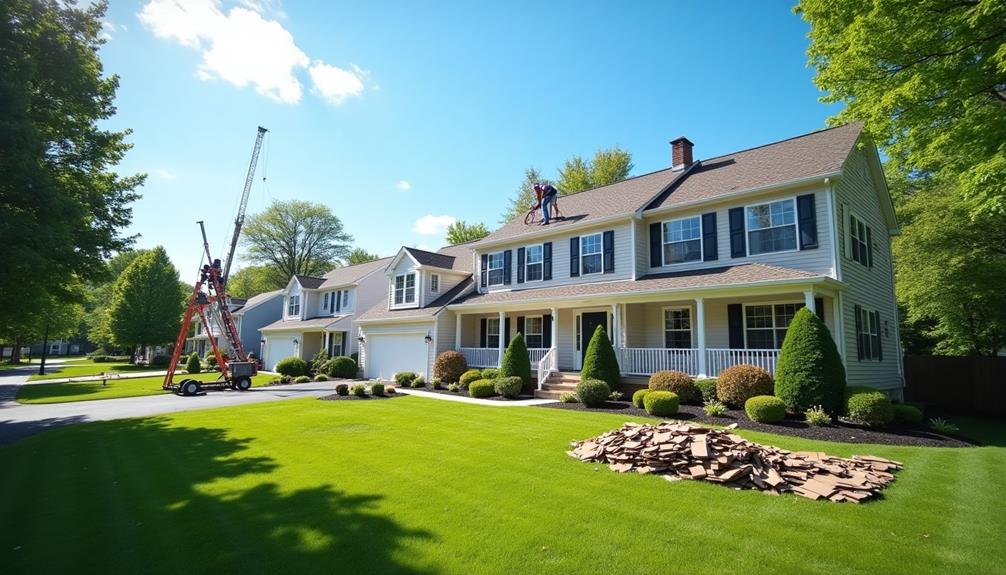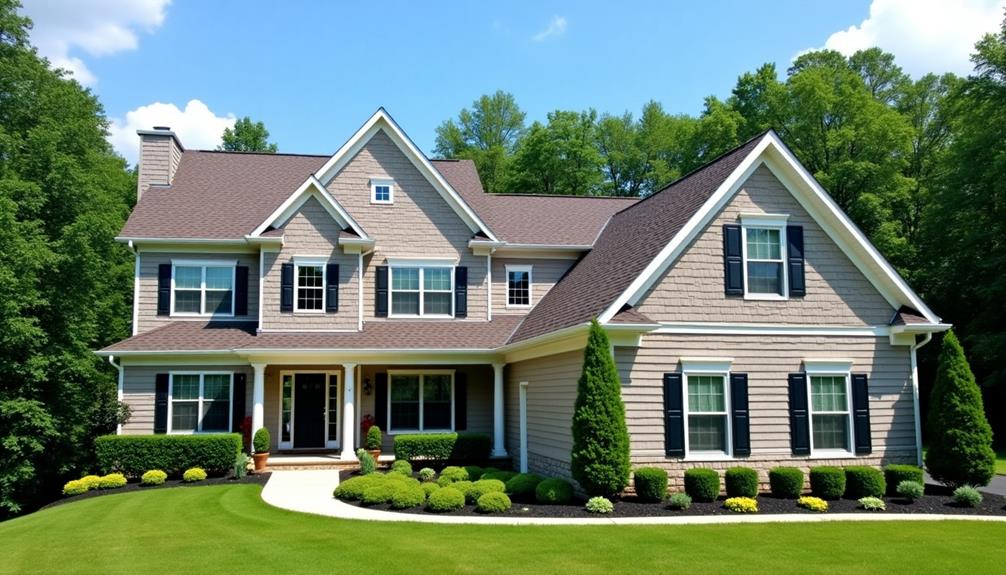If you're considering roof replacement in Voorhees, NJ, you're making a smart investment in safety and value. Look for signs like curling shingles or water stains, as they indicate it's time for a new roof. You'll need to choose materials based on your budget and climate, with options ranging from cost-effective asphalt shingles to durable metal roofing. Always ensure compliance with local building codes to avoid fines. Hiring qualified contractors is essential—they should have proper licensing and good reviews. A new roof not only boosts energy efficiency but also enhances curb appeal, setting the stage for future considerations.
Signs You Need a Roof Replacement
Recognizing the signs you need a roof replacement can save you from costly repairs down the line. One of the most crucial indicators is the roof's age; if it's nearing or exceeding its expected roof lifespan, replacement might be necessary. Most roofs last between 20 to 25 years, but factors like weather impact can significantly shorten this duration.
Check for curling, buckling, or missing shingles, as these often point to structural issues. If you notice granules in your gutters or excessive daylight peeking through your roof boards, it's a clear sign that your roof's integrity is compromised.
Water stains on your ceilings or walls suggest leaks, which can lead to major damage if ignored. If your roof has experienced severe weather, such as heavy storms or hail, consider a professional inspection. Even minor damage can escalate due to prolonged exposure to the elements.
Don't wait for a small issue to become a major problem. Taking action early can save you money and ensure your home remains safe and secure. Keep an eye on these signs, and you'll protect your investment effectively.
Choosing the Right Roofing Materials
How do you choose the right roofing materials for your home? Selecting the right materials is crucial for maximizing energy efficiency and enhancing aesthetic appeal. Begin by considering your climate, budget, and the architectural style of your home. Here's a quick comparison of popular roofing materials to guide you:
| Material | Benefits |
|---|---|
| Asphalt Shingles | Cost-effective, versatile designs |
| Metal | Durable, excellent energy efficiency |
| Tile | Long-lasting, unique aesthetic appeal |
Asphalt shingles are a go-to for many homeowners due to their affordability and variety. If you're looking for durability, metal roofing is a solid choice, providing longevity and energy efficiency. On the other hand, tile roofing offers a distinctive look and can withstand harsh weather, but it may come with a higher price tag.
Ultimately, the right choice hinges on balancing your budget with your energy efficiency goals and desired aesthetic appeal. Take your time to research and consult with professionals to ensure you make an informed decision for your roof replacement in Voorhees, NJ.
Understanding Local Building Codes
Before you start your roof replacement project in Voorhees, NJ, it's essential to familiarize yourself with local building codes. These local regulations dictate what's permissible during your roofing project, ensuring safety, quality, and compliance with community standards.
Understanding these codes can save you time, money, and stress in the long run.
First, you'll likely need to obtain building permits before commencing any work. These permits confirm that your project meets all the necessary requirements and allows local authorities to monitor construction practices.
Failing to secure the proper permits can result in fines or, worse, having to redo work that doesn't meet code.
Additionally, local building codes may specify the types of materials you can use, particularly regarding fire resistance and weather durability.
Make sure your chosen materials comply with these standards to avoid potential issues down the line.
Finding Qualified Contractors
Finding qualified contractors for your roof replacement in Voorhees, NJ, is crucial to ensuring the project's success. Start by gathering contractor referrals from friends, family, and online reviews. A good referral can save you time and help you find reputable professionals who've a proven track record.
Once you've compiled a list, it's time to interview potential contractors. Prepare a set of interviewing questions to gauge their expertise and reliability. Ask about their experience with roof replacements, the materials they recommend, and their warranty policies.
Inquire about their licensing and insurance to ensure you're protected against potential liabilities.
Don't hesitate to request references from past clients. Speaking with previous customers can provide valuable insight into the contractor's work ethic and quality.
Additionally, check for any complaints filed against them with the Better Business Bureau.
Cost Considerations for Replacement
When considering a roof replacement, understanding how material choices impact costs is crucial.
You'll also need to factor in labor expenses and any necessary permits and fees that may arise during the process.
Material Choices Impact Costs
Choosing the right materials for your roof replacement can significantly influence your overall costs. The durability of the materials you select will directly affect both the initial investment and long-term performance. For instance, asphalt shingles might be cheaper upfront, but metal or tile roofs often offer greater durability and require less maintenance over time.
Aesthetic appeal is another important factor. While you might be tempted to choose a less expensive option, consider how the color choices and overall look of your roof will impact your home's value. High-quality materials can enhance curb appeal, making it a worthwhile investment.
Don't overlook insulation properties and environmental impact, either. Energy-efficient materials can reduce your heating and cooling costs, offering savings that accumulate over the years. Additionally, many roofing materials come with warranty options that provide peace of mind and protection against premature failure.
Installation techniques can also vary based on material choice, influencing labor costs indirectly.
Ultimately, balancing these factors will help you make an informed decision that aligns with your budget while ensuring your new roof meets your needs for durability and aesthetic appeal.
Labor Expenses Overview
Labor expenses play a crucial role in the overall cost of your roof replacement project. Understanding the different labor types and their associated costs can help you budget more effectively. Typically, labor costs can vary based on the complexity of the job, the roofing material chosen, and the expertise of the contractors you hire.
Here's a breakdown of common labor types and their costs:
| Labor Type | Estimated Cost per Hour |
|---|---|
| General Labor | $20 – $35 |
| Skilled Labor | $35 – $60 |
| Specialized Labor | $60 – $100 |
General labor involves basic tasks such as material handling and cleanup, while skilled labor includes tasks that require more experience, like installing shingles. Specialized labor, on the other hand, may involve unique roofing systems or repairs that require advanced knowledge.
Permits and Fees
Securing the necessary permits and understanding associated fees is essential for a smooth roof replacement project in Voorhees, NJ. Before you start, familiarize yourself with the various permit types required for your roofing project. Typically, you'll need a building permit, which ensures your new roof complies with local building codes.
Depending on your project's scope, additional permits for electrical or structural work may be necessary.
Understanding the fee structures associated with these permits can save you from unexpected costs. Permit fees vary based on factors like the size of your roof, materials used, and even the complexity of the installation.
It's wise to consult the Voorhees township website or contact local officials for the most accurate fee schedule. Additionally, consider that some contractors might include permit costs in their estimates, while others might not, so clarify this aspect upfront.
The Replacement Process Explained
When you're ready to replace your roof, the process starts with an initial inspection to assess its condition and identify any underlying issues.
From there, you'll need to consider various material selection factors that can impact durability, aesthetics, and cost.
Understanding these steps ensures you make informed decisions that best suit your needs.
Initial Inspection Steps
Typically, before embarking on a roof replacement, a thorough initial inspection is crucial to identify any underlying issues that could affect the project. Start by assessing the current state of your roof, looking for signs of damage such as missing shingles, leaks, or sagging areas. This step is vital for evaluating the roof's structural integrity.
Next, perform a mold assessment. Mold can thrive in damp environments, often hidden under shingles or within the attic. If detected, it must be addressed before proceeding with replacement to prevent future complications and health risks.
During this inspection, also check the gutters and flashing, as these components can significantly impact your roof's performance. Examine the attic for proper ventilation, as inadequate airflow can lead to moisture buildup and reduce the lifespan of your new roof.
Documenting all findings will help you make informed decisions and communicate effectively with your roofing contractor. By taking these initial inspection steps, you're not only ensuring a smoother replacement process but also safeguarding your investment in the long run.
Don't overlook this critical phase; it lays the foundation for a successful roof replacement.
Material Selection Factors
After completing your initial inspection, you'll need to consider various material selection factors that will impact the durability, aesthetics, and cost of your new roof.
Start by evaluating your aesthetic preferences. Your roof's appearance significantly influences your home's overall look, so choose materials that complement your architectural style and enhance curb appeal.
Next, think about the environmental impact of your choices. Opting for sustainable materials like recycled shingles or metal roofing can reduce your carbon footprint and may even qualify you for local incentives.
Additionally, consider the energy efficiency of the materials. Some options, like reflective shingles, can help lower cooling costs by keeping your home cooler in the summer.
Durability is another critical factor. Different materials have varying lifespans and resistance to weather conditions.
For instance, slate and metal roofs often last longer than asphalt shingles, potentially saving you money on future replacements.
Maintenance Tips Post-Replacement
Keeping your new roof in top shape requires a proactive approach to maintenance. Begin with post-installation inspections within the first few months after your roof replacement. This ensures everything is secure and functioning as intended, addressing any issues before they escalate. It's vital to check for loose shingles, proper sealing around vents, and any signs of water intrusion.
Next, implement seasonal maintenance. Before winter, clear gutters and downspouts of debris to prevent ice dams. In spring, inspect for damage caused by snow or ice, and ensure your roof's drainage system is working effectively. Regularly trim overhanging branches to reduce wear and tear on shingles.
You should also take time to inspect your roof after severe weather events. Look for missing shingles or leaks that might've developed. Keeping an eye on these details helps extend your roof's lifespan and maintain its performance.
Lastly, consider scheduling annual professional inspections. A qualified contractor can identify potential problems you might overlook and recommend necessary repairs. By staying proactive, you're not just protecting your investment; you're ensuring your home remains safe and secure for years to come.
Benefits of a New Roof
When you invest in a new roof, you're not just enhancing your home's exterior; you're also reaping numerous benefits that contribute to its overall value and functionality.
One significant advantage is improved energy efficiency. Modern roofing materials often feature advanced insulation and reflective properties, which can help reduce heating and cooling costs. This means you'll not only save money on energy bills but also create a more comfortable living environment year-round.
In addition to energy savings, a new roof dramatically enhances your home's aesthetic appeal. Whether you opt for classic shingles, sleek metal, or eco-friendly materials, a fresh roof can elevate your property's curb appeal, making it more attractive to potential buyers.
This upgrade can greatly increase your home's market value, offering a solid return on investment.
Moreover, a new roof provides peace of mind. You'll benefit from the latest technology, warranties, and reduced maintenance concerns.
With a quality installation, you can expect durability and long-lasting performance, safeguarding your home against the elements.

